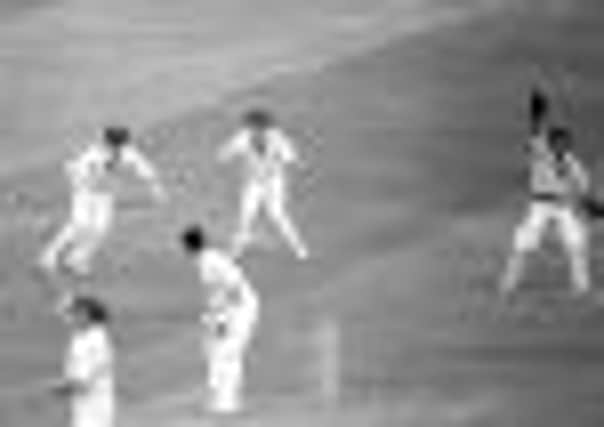Sporting Bygones: Gilmour swings it Australia’s way before blasting them home to victory against England in World Cup thriller at Headingley


For at Headingley on June 18 of that year, in the first semi-final in the first cricket World Cup, Australia’s Gary Gilmour delivered what is still one of the finest performances in ODI history.
First, the left-arm swing bowler took 6-14 from 12 overs as England were dismissed for 93.
Advertisement
Hide AdAdvertisement
Hide AdThen, batting at No 8 after his team slipped to 39-6 in reply, Gilmour top-scored with an unbeaten 28 to lead Australia to a four-wicket win.
Ironically, England had gone into the game more mindful of the threat posed by pace bowlers Dennis Lillee and Jeff Thomson.
Gilmour, a 23-year-old playing only the third of his five one-day internationals, pretty much snuck under the radar.
With Headingley choked in cloud and a stiff breeze blowing, it was felt that he was the man to exploit conditions – and so it proved.
Advertisement
Hide AdAdvertisement
Hide AdOpening the bowling from the Football Stand end, with long hair flowing and sideburns protruding, he captured the first six wickets to fall as England fell to 36-6 in their quest to reach the Lord’s final.
First, Gilmour had Dennis Amiss lbw and then bowled fellow opening batsman Barry Wood with a splendid yorker.
Tony Greig edged to wicketkeeper Rod Marsh, who claimed a flying one-handed catch to his right, before Frank Hayes was trapped in front playing back.
Further lbw decisions accounted for Keith Fletcher and Alan Knott during an unchanged 12-over spell which included six maidens.
Advertisement
Hide AdAdvertisement
Hide AdMax Walker, the right-arm fast-medium bowler, had Chris Old caught by Greg Chappell to leave England 37-7 before Lillee – reduced to the unfamiliar role of bit-part – finally got in on the act when he captured the eighth wicket with the total on 52, John Snow perishing to a catch behind.
Walker rounded off the innings by bowling England captain Mike Denness for a top-score of 27 and having last man Peter Lever lbw.
“Bowling a full length, over the wicket, he (Gilmour) not only swung the ball in the heavy atmosphere, but he moved it both ways after pitching,” reported Wisden.
Five of Gilmour’s wickets came from in-swingers, Greig the only man to perish to away-swing.
Advertisement
Hide AdAdvertisement
Hide AdThe sideways movement and variable bounce that upset England so nearly undermined Australia, too.
The visitors were 55 runs short of victory with only four wickets left when Gilmour strode to the middle to join Doug Walters, the stylish right-hander.
However, Gilmour threw the bat to good effect, survived a chance to Greig in the slips with the total on 78 and kept his nerve in challenging circumstances.
Walters chipped in with an unbeaten 20 and Australia prevailed – somewhat incongruously given the clatter of wickets – with a whopping 31.2 overs to spare.
Advertisement
Hide AdAdvertisement
Hide AdInevitably, there followed some criticism of the Headingley surface, which was often cited as unsuitable.
However, Wisden countered: “There was no feeling of being cheated by anyone in the capacity crowd.
“There was tremendous excitement, especially when Australia, in search of 94 runs needed to win, lost six wickets for 39 runs.
“Gasps, groans or cheers followed every ball.”
Three days later, Gilmour was at it again.
He took 5-48 in the final against the West Indies, but Australia lost by 17 runs.
Advertisement
Hide AdAdvertisement
Hide AdHowever, it was his performance at Headingley for which he is always remembered, one which earned him the man-of-the-match award and a place in the game’s folklore.
Some years later, the player reflected modestly on his efforts that day.
“They kept shouldering arms and the ball swung back in and did the rest. I just wanted to bowl and bowl; I did not want my overs to run out.”
Gilmour, whose style drew comparisons with fellow New South Welshman Alan Davidson, has just turned 61 years of age.
Advertisement
Hide AdAdvertisement
Hide AdBack in 2005, he was engaged in an altogether different kind of battle – a battle for life.
Gilmour underwent a liver transplant following a fund-raising campaign spearheaded by Ian Chappell, his captain on that famous day at Headingley.
A romantic at heart, Gilmour once confessed he could not have thrived in the cricket of the modern era.
“I couldn’t play under today’s conditions,” he reflected, “what with the travelling and training and scientific aspects.
“It’s not a sport any more, it’s like going to work.
“You know how some mornings you get up and don’t want to go to work – that’s how I’d feel playing cricket these days.
“I’d clock on for a sickie.”